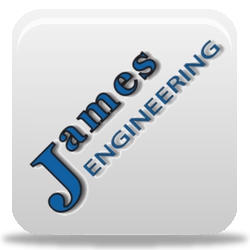Metal Deburring Machine & Other Burr Removal/Surface Finishing Methods.
Achieving Precision and Quality Machining
Metal Deburring machine and metal edge chamfering are James Engineering’s specialty, but let’s look at why metal parts' deburring and surface finishing are important. We’ll look at what methods are best for achieving precision and quality and express a better understanding of part finishings.
Understanding Metal Burr Formations
Metal burrs are protrusions that are caused when metal is machined, cut, or stamped. Protrusions will vary based on the size, shape, and material of the component. Improperly treated they will compromise the functionality, performance, and lifespan of parts.
Challenges in Traditional Burr Removal Methods:
Traditional deburring methods such as manual, mechanical, or even some automatic techniques pose challenges for optimal results. Inconsistent finishes, secondary burrs, or damage to the component that could lead to a scrapped part are all products of these traditional methods.
Manual Deburring: Manual deburring involves handheld tools such as a file, deburring knife, or abrasive pads. While this method offers control, it is labor-intensive, time-consuming, and impossible to produce consistent results. This also makes it less suitable for high-volume productions.
Mechanical: Mechanical deburring uses simple devices like automatic hand tools or tumblers. Though less labor-intensive than manual methods, each form carries its disadvantages. Automatic hand tools are still inconsistent while devices like tumblers or vibes could still slow down production with long cycle times. Errors of collusion could also result from batch processes and these devices will put a finish on the whole part when something more precise may be needed.
Automatic: Automatic deburring also comes in several forms. Machines like typical CNCs or robotic arms can be attached with tools for burr removal. Typical CNCs aren’t originally meant for the deburring process though. Specific abrasives used for deburring can damage these CNC machines when broken down, especially at the volume required for deburring. They also require complex programming that heavily relies on well-versed operators. One of the biggest issues with these CNCs and robots is being able to compensate for the differences between a physical component and its design. No part is exact, especially with processes such as forging or casting where flash is created. Tool wear is also something these machines can’t understand. They lack “Machine Compliance” and will lead to over/under-engaging causing broken tools or inconsistent parts.
MAX SYSTEMS Machine
“Machine Compliance” is a technology that James Engineering patented. MAX Systems mechanically make up for inconsistencies allowing them to repeatably produce perfect finishes. Cycle times are typically finished in seconds, but more importantly, the change over time can also be completed in seconds even for a completely different part. James’ machines have an extensive memory on them allowing for “recipes” to be called up for each part with just a push of a button. They also don’t require experienced operators, they are designed for anybody to run with a user-friendly control panel. Though these machines are designed for deburring and chamfering they have the capability to produce a diverse array of finishes.
The Need for an Optimized Metal Deburring Machine
Traditional deburring methods, including manual, mechanical, and even some automatic techniques, often fall short of delivering optimal results. Manual deburring is labor-intensive and inconsistent, making it unsuitable for high-volume production. Mechanical deburring methods, like automatic hand tools and tumblers, can be inefficient and prone to errors, while typical CNC machines and robotic arms face challenges with programming complexity and tool wear, leading to inconsistent outcomes.
By prioritizing advanced deburring and chamfering technologies, James Engineering ensures precision, consistency, and quality in metal part finishing, setting a new standard in the industry.




